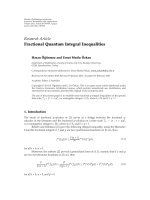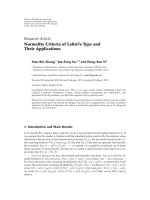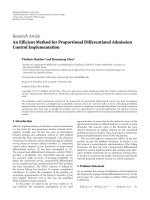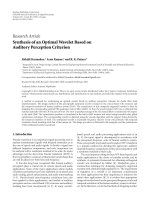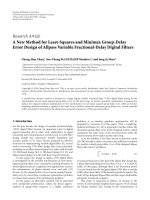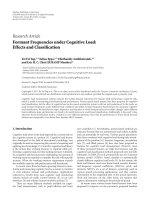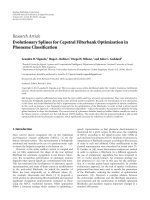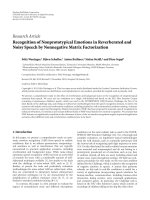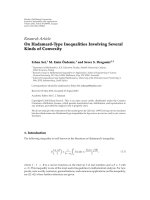Báo cáo hóa học: " Research Article Fractional Quantum Integral Inequalities ¨ ˘¨ ¨ Hasan Ogunmez and Umut Mutlu Ozka" potx
Bạn đang xem bản rút gọn của tài liệu. Xem và tải ngay bản đầy đủ của tài liệu tại đây (469.45 KB, 7 trang )
Hindawi Publishing Corporation
Journal of Inequalities and Applications
Volume 2011, Article ID 787939, 7 pages
doi:10.1155/2011/787939
Research Article
Fractional Quantum Integral Inequalities
Hasan
¨
O˘g¨unmez and Umut Mutlu
¨
Ozkan
Department of Mathematics, Faculty of Science and Arts, Kocatepe University,
03200 Afyonkarahisar, Turkey
Correspondence should be addressed to Umut Mutlu
¨
Ozkan, umut
Received 10 November 2010; Revised 1 9 January 2011; Accepted 16 February 2011
Academic Editor: J. Szabados
Copyright q 2011 H.
¨
O
˘
g
¨
unmez and U. M.
¨
Ozkan. This is an open access article distributed under
the Creative Commons Attribution License, which permits unrestricted use, distribution, and
reproduction in any medium, provided the original work is properly cited.
The aim of the present paper is to establish some fractional q-integral inequalities on the specific
time scale,
t
0
{t : t t
0
q
n
, n a nonnegative integer}∪{0},wheret
0
∈ ,and0<q<1.
1. Introduction
The study of fractional q-calculus in 1 serves as a bridge between the fractional q-
calculus in the literature and the fractional q-calculus on a time scale
t
0
{t : t t
0
q
n
,
n a nonnegative integer}∪{0},wheret
0
∈ ,and0<q<1.
Belarbi and Dahmani 2 gave the following integral inequality, using the Riemann-
Liouville fractional integral: if f and g are two synchronous functions on 0, ∞,then
J
α
fg
t
≥
Γ
α 1
t
α
J
α
f
t
J
α
g
t
,
1.1
for all t>0, α>0.
Moreover, the authors 2 proved a generalized form of 1.1,namelythatiff and g
are two synchronous functions on 0, ∞,then
t
α
Γ
α 1
J
β
fg
t
t
β
Γ
β 1
J
α
fg
t
≥ J
α
f
t
J
β
g
t
J
β
f
t
J
α
g
t
,
1.2
for all t>0, α>0, and β>0.
2 Journal of Inequalities and Applications
Furthermore, the authors 2 pointed out that if f
i
i1,2, ,n
are n positive increasing
functions on 0, ∞,then
J
α
n
i1
f
i
t
≥
J
α
f
1
1−n
n
i1
J
α
f
i
t
, 1.3
for any t>0, α>0.
In this paper, we have obtained fractional q-integral inequalities, which are quantum
versions of inequalities 1.1, 1.2,and1.3, on the specific time scale
t
0
{t : t t
0
q
n
,
n a nonnegative integer}∪{0},wheret
0
∈ ,and0<q<1. In general, a time scale is an
arbitrary nonempty closed subset of the real numbers 3.
Many authors have studied the fractional integral inequalities and applications. For
example, we refer the reader to 4–6.
To the best of our knowledge, this paper i s the first one that focuses on fractional q-
integral inequalities.
2. Description of Fractional q-Calculus
Let t
0
∈ and define
t
0
t : t t
0
q
n
,na nonnegative integer
∪
{
0
}
, 0 <q<1. 2.1
If there is no confusion concerning t
0
, we will denote
t
0
by .Forafunctionf : → ,the
nabla q-derivative of f is
∇
q
f
t
f
qt
− f
t
q − 1
t
2.2
for all t ∈
\{0}.Theq-integral of f is
t
0
f
s
∇s
1 − q
t
∞
i0
q
i
f
tq
i
.
2.3
The fundamental theorem of calculus applies to the q-derivative and q-integral; in particular,
∇
q
t
0
f
s
∇s f
t
,
2.4
and if f is continuous at 0, then
t
0
∇
q
f
s
∇s f
t
− f
0
.
2.5
Journal of Inequalities and Applications 3
Let
t
1
,
t
2
denote two time scales. Let f :
t
1
→ be continuous let g :
t
1
→
t
2
be
q-differentiable, strictly increasing, and g00. Then for b ∈
t
1
,
b
0
f
t
∇
q
g
t
∇t
gb
0
f ◦ g
−1
s
∇s.
2.6
The q-factorial function is defined in the following way: if n is a positive integer, then
t − s
n
t − s
t − qs
t − q
2
s
···
t − q
n−1
s
. 2.7
If n is not a positive integer, then
t − s
n
t
n
∞
k0
1 −
s/t
q
k
1 −
s/t
q
nk
.
2.8
The q-derivative of the q-factorial function with respect to t is
∇
q
t − s
n
1 − q
n
1 − q
t − s
n−1
,
2.9
and the q-derivative of the q-factorial function with respect to s is
∇
q
t − s
n
−
1 − q
n
1 − q
t − qs
n−1
.
2.10
The q-exponential function is defined as
e
q
t
∞
k0
1 − q
k
t
,e
q
0
1.
2.11
Define the q-Gamma function by
Γ
q
ν
1
1 − q
1
0
t
1 − q
ν−1
e
q
qt
∇t, ν ∈
.
2.12
Note that
Γ
q
ν 1
ν
q
Γ
q
ν
,ν∈
, where
ν
q
:
1 − q
ν
1 − q
.
2.13
The fractional q-integral is defined as
∇
−ν
q
f
t
1
Γ
q
ν
t
0
t − qs
ν−1
f
s
∇s.
2.14
4 Journal of Inequalities and Applications
Note that
∇
−ν
q
1
1
Γ
q
ν
q − 1
q
ν
− 1
t
ν
1
Γ
q
ν 1
t
ν
.
2.15
More results concerning fractional q-calculus can be found in 1, 7–9.
3. Main Results
In this section, we will state our main results and give their proofs.
Theorem 3.1. Let f and g be two synchronous functions on
t
0
. Then for all t>0, ν>0,wehave
∇
−ν
q
fg
t
≥
Γ
q
ν 1
t
ν
∇
−ν
q
f
t
∇
−ν
q
g
t
.
3.1
Proof. Since f and g are synchronous functions on
t
0
,weget
f
s
− f
ρ
g
s
− g
ρ
≥ 0 3.2
for all s>0, ρ>0. By 3.2,wewrite
f
s
g
s
f
ρ
g
ρ
≥ f
s
g
ρ
f
ρ
g
s
. 3.3
Multiplying both side of 3.3 by t − qs
ν−1
/Γ
q
ν,wehave
t − qs
ν−1
Γ
q
ν
f
s
g
s
t − qs
ν−1
Γ
q
ν
f
ρ
g
ρ
≥
t − qs
ν−1
Γ
q
ν
f
s
g
ρ
t − qs
ν−1
Γ
q
ν
f
ρ
g
s
.
3.4
Integrating both sides of 3.4 with respect to s on 0,t,weobtain
1
Γ
q
ν
t
0
t − qs
ν−1
f
s
g
s
∇s
1
Γ
q
ν
t
0
t − qs
ν−1
f
ρ
g
ρ
∇s
≥
1
Γ
q
ν
t
0
t − qs
ν−1
f
s
g
ρ
∇s
1
Γ
q
ν
t
0
t − qs
ν−1
f
ρ
g
s
∇s.
3.5
Journal of Inequalities and Applications 5
So,
∇
−ν
q
fg
t
f
ρ
g
ρ
1
Γ
q
ν
t
0
t − qs
ν−1
∇s
≥
g
ρ
Γ
q
ν
t
0
t − qs
ν−1
f
s
∇s
f
ρ
Γ
q
ν
t
0
t − qs
ν−1
g
s
∇s.
3.6
Hence, we have
∇
−ν
q
fg
t
f
ρ
g
ρ
∇
−ν
q
1
≥ g
ρ
∇
−ν
q
f
t
f
ρ
∇
−ν
q
g
t
.
3.7
Multiplying both side of 3.7 by t − qρ
ν−1
/Γ
q
ν,weobtain
t − qρ
ν−1
Γ
q
ν
∇
−ν
q
fg
t
t − qρ
ν−1
Γ
q
ν
f
ρ
g
ρ
∇
−ν
q
1
≥
t − qρ
ν−1
Γ
q
ν
g
ρ
∇
−ν
q
f
t
t − qρ
ν−1
Γ
q
ν
f
ρ
∇
−ν
q
g
t
.
3.8
Integrating both side of 3.8 with respect to ρ on 0,t,weget
∇
−ν
q
fg
t
t
0
t − qρ
ν−1
Γ
q
ν
∇ρ
∇
−ν
q
1
Γ
q
ν
t
0
f
ρ
g
ρ
t − qρ
ν−1
∇ρ
≥
∇
−ν
q
f
t
Γ
q
ν
t
0
t − qρ
ν−1
g
ρ
∇ρ
∇
−ν
q
g
t
Γ
q
ν
t
0
t − qρ
ν−1
f
ρ
∇ρ.
3.9
Obviously,
∇
−ν
q
fg
t
≥
1
∇
−ν
q
1
∇
−ν
q
f
t
∇
−ν
q
g
t
Γ
q
ν 1
t
ν
∇
−ν
q
f
t
∇
−ν
q
g
t
3.10
and the proof is complete.
The following result may be seen as a generalization of Theorem 3.1.
Theorem 3.2. Let f and g be as in Theorem 3.1. Then for all t>0, ν>0, μ>0 we have
t
ν
Γ
q
ν 1
∇
−μ
q
fg
t
t
μ
Γ
q
μ 1
∇
−ν
q
fg
t
≥∇
−ν
q
f
t
∇
−μ
q
g
t
∇
−μ
q
f
t
∇
−ν
q
g
t
.
3.11
6 Journal of Inequalities and Applications
Proof. By making similar calculations as in Theorem 3.1 we have
t − qρ
μ−1
Γ
q
μ
∇
−ν
q
fg
t
∇
−ν
q
1
t − qρ
μ−1
Γ
q
μ
f
ρ
g
ρ
≥
t − qρ
μ−1
Γ
q
μ
g
ρ
∇
−ν
q
f
t
t − qρ
μ−1
Γ
q
μ
f
ρ
∇
−ν
q
g
t
.
3.12
Integrating both side of 3.12 with respect to ρ on 0,t,weobtain
∇
−ν
q
fg
t
t
0
t − qρ
μ−1
Γ
q
μ
∇ρ
∇
−ν
q
1
Γ
q
μ
t
0
f
ρ
g
ρ
t − qρ
μ−1
∇ρ
≥
∇
−ν
q
f
t
Γ
q
μ
t
0
t − qρ
μ−1
g
ρ
∇ρ
∇
−ν
q
g
t
Γ
q
μ
t
0
t − qρ
μ−1
f
ρ
∇ρ.
3.13
Thus, 3.11 holds for all t>0, ν>0, μ>0, so the proof is complete.
Remark 3.3. The inequalities 3.1 and 3.11 are reversed if the functions are asynchronous
on
t
0
i.e., fx − fygx − gy ≤ 0, for any x, y ∈
t
0
.
Theorem 3.4. Let f
i
i1, ,n
be n positive increasing functions on
t
0
. Then for any t>0, ν>0 we
have
∇
−ν
q
n
i1
f
i
t
≥
∇
−ν
q
1
1−n
n
i1
∇
−ν
q
f
i
t
. 3.14
Proof. We prove this theorem by induction.
Clearly, for n 1, we have
∇
−ν
q
f
1
t
≥∇
−ν
q
f
1
t
,
3.15
for all t>0, ν>0.
For n 2, applying 3.1,weobtain
∇
−ν
q
f
1
f
2
t
≥
∇
−ν
q
1
−1
∇
−ν
q
f
1
t
∇
−ν
q
f
2
t
,
3.16
for all t>0, ν>0.
Suppose that
∇
−ν
q
n−1
i1
f
i
t
≥
∇
−ν
q
1
2−n
n−1
i1
∇
−ν
q
f
i
t
,t>0,ν>0.
3.17
Journal of Inequalities and Applications 7
Since f
i
i1, ,n
are positive increasing functions, then
n−1
i1
f
i
t is an increasing function.
Hence, we can apply Theorem 3.1 to the functions
n−1
i1
f
i
g, f
n
f.Weobtain
∇
−ν
q
n
i1
f
i
t
∇
−ν
q
fg
t
≥
∇
−ν
q
1
−1
∇
−ν
q
n−1
i1
f
i
t
∇
−ν
q
f
n
t
.
3.18
Taking into account the hypothesis 3.17,weobtain
∇
−ν
q
n
i1
f
i
t
≥
∇
−ν
q
1
−1
∇
−ν
q
1
2−n
n−1
i1
∇
−ν
q
f
i
t
∇
−ν
q
f
n
t
3.19
and this ends the proof.
Acknowledgment
The a uthors thank referees for suggestions which have improved the final version of this
paper.
References
1 F. M. Atıcı and P. W. Eloe, “Fractional q-calculus on a time scale,” Journal of Nonlinear Mathematical
Physics, vol. 14, no. 3, pp. 341–352, 2007.
2 S. Belarbi and Z. Dahmani, “On some new fractional integral inequalities,” Journal of Inequalities in Pure
and Applied Mathematics, vol. 10, no. 3, a rticle 86, 5 pages, 2009.
3 M. Bohner and A. Peterson, Dynamic Equations on Time Scales,Birkh
¨
auser, Boston, Mass, USA, 2001.
4 Z. Denton and A. S. Vatsala, “Fractional integral inequalities and applications,” Computers & Mathe-
matics with Applications, vol. 59, no. 3, pp. 1087–1094, 2010.
5 G. A. Anastassiou, “Multivariate fractional Ostrowski type inequalities,” Computers & Mathematics with
Applications, vol. 54, no. 3, pp. 434–447, 2007.
6 G. A. Anastassiou, “Opial type inequalities involving fractional derivatives of two functions and
applications,” Computers & Mathematics with Applications, vol. 48, no. 10-11, pp. 1701–1731, 2004.
7 R. P. Agarwal, “Certain fractional q-integrals and q-derivatives,” Proceedings of the Cambridge Philosoph-
ical Society, vol. 66, pp. 365–370, 1969.
8 W. A. Al-Salam, “Some fractional q-integrals and q-derivatives,” Proceedings of the Edinburgh Mathemat-
ical Society. Series II, vol. 15, pp. 135–140, 1966.
9 P. M. Rajkovi
´
c, S. D. Marinkovi
´
c, and M. S. Stankovi
´
c, “A generalization of the concept of q-fractional
integrals,” Acta Mathematica Sinica (English S eries), vol. 25, no. 10, pp. 1635–1646, 2009.
